Activating transcription factor 6, also known as ATF6, is a protein that, in humans, is encoded by the ATF6 gene [5] [6] [7] and is involved in the unfolded protein response.
Activating transcription factor 6, also known as ATF6, is a protein that, in humans, is encoded by the ATF6 gene [5] [6] [7] and is involved in the unfolded protein response.
ATF6 is an endoplasmic reticulum (ER) stress-regulated transmembrane transcription factor that activates the transcription of ER molecules. [8] Accumulation of misfolded proteins in the Endoplasmic Reticulum results in the proteolytic cleavage of ATF6. The cytosolic portion of ATF6 will move to the nucleus and act as a transcription factor to cause the transcription of ER chaperones.
ATF6 has been shown to interact with YY1 [9] and Serum response factor. [6]
The unfolded protein response (UPR) is a cellular stress response related to the endoplasmic reticulum (ER) stress. It has been found to be conserved between mammalian species, as well as yeast and worm organisms.

X-box binding protein 1, also known as XBP1, is a protein which in humans is encoded by the XBP1 gene. The XBP1 gene is located on chromosome 22 while a closely related pseudogene has been identified and localized to chromosome 5. The XBP1 protein is a transcription factor that regulates the expression of genes important to the proper functioning of the immune system and in the cellular stress response.

Cyclic AMP-dependent transcription factor ATF-1 is a protein that in humans is encoded by the ATF1 gene.

Activating transcription factor 4 , also known as ATF4, is a protein that in humans is encoded by the ATF4 gene.

Serum response factor, also known as SRF, is a transcription factor protein.

Binding immunoglobulin protein (BiPS) also known as 78 kDa glucose-regulated protein (GRP-78) or heat shock 70 kDa protein 5 (HSPA5) is a protein that in humans is encoded by the HSPA5 gene.

DNA damage-inducible transcript 3, also known as C/EBP homologous protein (CHOP), is a pro-apoptotic transcription factor that is encoded by the DDIT3 gene. It is a member of the CCAAT/enhancer-binding protein (C/EBP) family of DNA-binding transcription factors. The protein functions as a dominant-negative inhibitor by forming heterodimers with other C/EBP members, preventing their DNA binding activity. The protein is implicated in adipogenesis and erythropoiesis and has an important role in the cell's stress response.

Protein phosphatase 1 regulatory subunit 15A, also known as growth arrest and DNA damage-inducible protein (GADD34), is a protein that in humans is encoded by the PPP1R15A gene.

Eukaryotic translation initiation factor 2-alpha kinase 3, also known as protein kinase R (PKR)-like endoplasmic reticulum kinase (PERK), is an enzyme that in humans is encoded by the EIF2AK3 gene.

The serine/threonine-protein kinase/endoribonuclease inositol-requiring enzyme 1 α (IRE1α) is an enzyme that in humans is encoded by the ERN1 gene.

Nuclear transcription factor Y subunit gamma is a protein that in humans is encoded by the NFYC gene.

Homocysteine-responsive endoplasmic reticulum-resident ubiquitin-like domain member 1 protein is a protein that in humans is encoded by the HERPUD1 gene.

Cyclic AMP-responsive element-binding protein 3 is a protein that in humans is encoded by the CREB3 gene.

Nuclear factor erythroid 2-related factor 1 (Nrf1) also known as nuclear factor erythroid-2-like 1 (NFE2L1) is a protein that in humans is encoded by the NFE2L1 gene. Since NFE2L1 is referred to as Nrf1, it is often confused with nuclear respiratory factor 1 (Nrf1).

ETS domain-containing protein Elk-4 is a protein that in humans is encoded by the ELK4 gene.

Activating transcription factor 5, also known as ATF5, is a protein that, in humans, is encoded by the ATF5 gene.

CAMP responsive element binding protein-like 1, also known as CREBL1, is a protein which in humans is encoded by the CREBL1 gene.

General transcription factor IIF subunit 1 is a protein that in humans is encoded by the GTF2F1 gene.

The bZIP intron RNA motif is an RNA structure guiding splicing of a non-canonical intron from bZIP-containing genes called HAC1 in yeast, XBP1 in Metazoa, Hxl1 or Cib1 in Basidiomycota and bZIP60 in plants. Splicing is performed independently of the spliceosome by Ire1, a kinase with endoribonuclease activity. Exons are joined by a tRNA ligase. Recognition of the intron splice sites is mediated by a base-paired secondary structure of the mRNA that forms at the exon/intron boundaries. Splicing of the bZIP intron is a key regulatory step in the unfolded protein response (UPR). The Ire-mediated unconventional splicing was first described for HAC1 in S. cerevisiae.
Beta cells are heavily engaged in the synthesis and secretion of insulin. They are therefore particularly sensitive to endoplasmic reticulum (ER) stress and the subsequent unfolded protein response (UPR). Severe or prolonged episodes of ER stress can lead to the death of beta cells, which can contribute to the development of both Type I and Type II diabetes.
This article incorporates text from the United States National Library of Medicine, which is in the public domain.